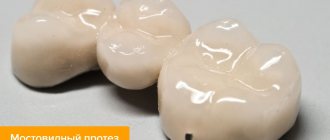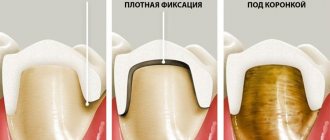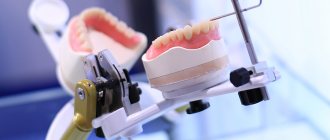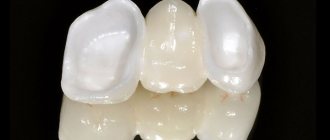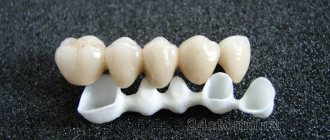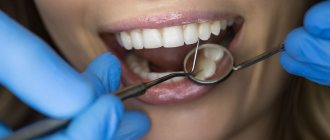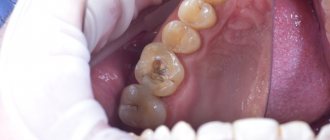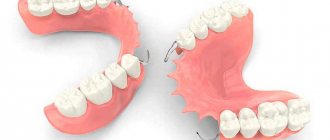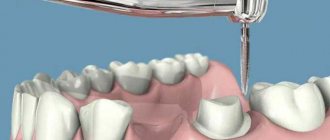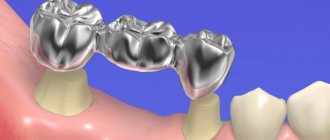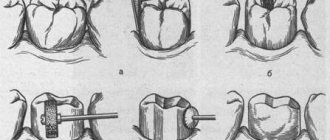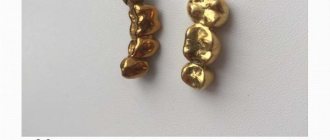Dental bridges are a modern and reliable method of prosthetics. In essence, it is simple - several connected crowns are put on the teeth. The central ones restore missing teeth, and the outer ones are made in the form of caps and are put on the ground supporting dental units.
Bridges
Advantages
- Strong fixation, there is no chance that the structure will fall out;
- For care, it does not need to be removed from the mouth; it can be cleaned like regular teeth;
- Restores both one and several missing teeth in a row;
- There are different material options;
- The classic design is cheaper than implant prosthetics;
- Can be placed on implants for prosthetics in the absence of supporting teeth.
Due to these advantages, a dental bridge is considered one of the best prosthetic options.
pros
Solid-cast bridges are very popular due to the following positive aspects:
- After the installation of such a structure, the dentition completely restores its functionality.
- The structure is attached very tightly and securely, practically eliminating the possibility of pieces of food, saliva and microbes getting under it.
- Durability, you can use it for about 10 years.
- High strength due to the absence of solder and soldering elements.
- The ability to model during manufacturing not only the intermediate part of the bridge, but also the supporting teeth, which significantly increases the functionality of the structure.
- Gentle grinding of supporting teeth.
- Affordable price.
Kinds
There are several types of dental bridges:
- Traditional option, consisting of several crowns and two supporting crowns at the edges;
- Cantilever, with support on one side only. It is used in the absence of teeth at the end of the dentition;
- Cast prosthesis, individually made from metal;
- A stamped prosthesis in which the crowns are adjusted to the patient;
- A bridge prosthesis with locks, which is attached to the supporting teeth using special structures;
- An adhesive bridge, in which fastening is carried out not by putting on crowns, but by cutting out grooves in the supporting teeth and installing protruding elements of the prosthesis there on the adhesive;
- Prosthesis on implants - the outermost elements are attached not to teeth, but to titanium roots implanted into the jaw, which allows you to avoid grinding of teeth and carry out prosthetics in almost any situation.
The choice of method depends on the condition of the patient’s teeth and oral cavity, as well as his financial capabilities.
Bridge prosthesis for restoration of one tooth
A dental bridge fell out: what to do?
Dental bridges, as well as dental crowns, as well as other orthopedic structures, have a service life, after which they must be replaced. Modern materials and manufacturing and installation technologies make the shelf life of orthopedic structures quite long, but this does not negate the mandatory removal of a dental bridge whose shelf life has expired. Unfortunately, many patients, if not the majority, ignore the need to remove the bridge and replace it with a new one until the problem becomes a rib, that is, until the dental bridge falls off.
A timely, regular visit to the dentist will help to avoid such a problem, who will be able to detect that the dental bridge has become loose or has begun to collapse, before the patient feels it himself. The fact is that the shelf life of a bridge is limited not so much by the properties of the manufacturing material itself (with proper care it is practically not subject to erosion), but by the fragility of the composite materials with which the lateral crowns of the bridge are attached to the supporting teeth, as well as the danger of development under these crowns secondary caries, which is aggravated by the fact that the supporting teeth are most often “dead”, pulpless, which reduces their resistance to carious lesions. So how is a dental bridge removed? Considering that after removing the bridge, a new one needs to be installed in its place (in rare cases, it is possible to install the same structure if it is not damaged, but with fresh cement), it is very important not to damage the supporting teeth in order to avoid even further grinding of them. For this purpose, special ultrasonic devices are used, which cause the cement between the crown and the tooth to crumble, after which the bridge is removed.
If the dental bridge breaks and falls off, you must immediately consult a doctor, since the ground supporting teeth should not be open, this will lead to their damage, in addition, the bridge could become detached traumatically, and only a specialist can notice and correct this.
Very often on various forums you can come across the question: “What to do if the dental bridge is wobbly?” The answer is simple: consult a doctor immediately. Perhaps the installation technology was violated or the design was not accurately adjusted to the ground abutment teeth. If the dental bridge begins to sway several years after installation, this may indicate the presence of the above-mentioned secondary caries or partial destruction of the cement between the crown and the tooth tissues.
It is also necessary to consult a specialist if you experience toothache under the bridge. This is another sign of secondary caries. If the gums hurt at the point of contact with the central part of the bridge, perhaps the structure was set too deeply, which caused rubbing of the soft tissues by the edge of the bridge, and this in turn can lead to the formation of bruises and bedsores, and in advanced cases, to an inflammatory process.
If chips or microcracks have formed on the artificial enamel of a dental bridge (in the case of ceramic and metal-ceramic structures), it is most often possible to repair dental bridges with composite materials directly in the patient’s oral cavity. In some cases, it is also possible to repair structures made of plastic and metal-plastic. WARNING: If you swallow a dental bridge or a fragment of it, go to a clinic or emergency room. An ultrasound examination of the gastrointestinal tract may be required, since the sharp edges of the chips can damage the mucous membranes of the stomach, esophagus and intestines.
Materials
Typically, dental bridges are made from the following materials:
- Metal is a classic durable option and was the only option for many years. It lasts a long time, easily copes with different chewing loads, but is too unaesthetic, so now it is mainly placed only on the back teeth. It costs the least;
- Metal ceramics are a more expensive option with improved aesthetics. It is a metal frame coated with ceramic, making the structure white and similar to natural teeth. Still very durable, although aesthetically inferior to other options;
- Solid ceramics are very aesthetic, but expensive and fragile prostheses. Due to the absence of a frame, they allow you to create a natural color and transparency of the teeth, but they cannot withstand heavy chewing load. It is recommended to place it in the anterior part of the jaw;
- Zirconium dioxide is a modern material that is both extremely durable and aesthetically pleasing. Unfortunately, it is quite expensive, but it lasts a long time and is ultimately quite economical.
- Combined designs - combine metal and metal-ceramics. They are placed if some of the teeth fall into the smile zone - then they are covered with ceramics for better aesthetics, leaving the invisible teeth metal to save money;
- Metal-plastic is an inexpensive option in which the metal is coated with white plastic to match the color of the teeth. Does not provide sufficient aesthetics and deteriorates quickly, so is rarely used;
- Plastic is a material for temporary bridges that are installed before the permanent ones are made. Not suitable for regular wear due to fragility and tendency to accumulate harmful bacteria.
The material is usually selected based on the wishes and financial capabilities of the patient, as well as depending on the area of prosthetics.
Plastic bridges
Minuses
Solid cast structures also have their downsides. Let's consider the main ones:
- Low aesthetics, which involves the use of such structures for chewing teeth that are not visible to others.
- When eating hot food, the patient may feel discomfort, which is explained by the high thermal conductivity of the metal.
- Grinding of support teeth necessary for attaching the prosthesis.
- Possibility of periodontal overload if the model is not designed correctly.
- The price exceeds the cost of removable dentures.
- Possibility of gradual loosening of supporting teeth due to heavy load.
- The denture makes it difficult to maintain oral hygiene.
Stages of prosthetics
The installation of the bridge takes place in several stages:
- Sanitation of the oral cavity, treatment of caries and gum inflammation;
- Inspection and selection of prosthetic options;
- Grinding of teeth if necessary, or implantation of implants;
- Taking impressions;
- Installation of a temporary plastic prosthesis;
- Fixation of the finished prosthesis with dental cement.
Now let's look at the stages of making a bridge:
- The taken impressions are sent to the laboratory, where they are used to make a plaster model of the jaw;
- Using the model, the technician makes a frame that is fitted to the patient’s teeth;
- The frame is adjusted and wax casts are taken for the structure itself;
- The material is selected, and the technician casts the frame from it, lining it with ceramics if necessary and baking everything in the oven.
What material is used for solid bridges?
Alloys of base metals (nickel and chromium, cobalt and chromium), as well as alloys of silver with palladium, gold with platinum and pure gold are used as the main material for the manufacture of solid bridges.
Chromium-nickel alloys are the most affordable, but in this case allergic reactions to nickel are common. Also, chromium-nickel alloys are at risk of rapid deformation because they are not strong enough.
Solid-cast bridges made of chromium-cobalt alloys have greater hardness. Individual intolerance to such a composition is also much less common.
Alloys of noble metals are the best option for the manufacture of orthopedic structures. They are highly resistant to corrosion and have excellent compatibility with oral tissues.
Disadvantages and Alternatives
The main disadvantage of a bridge is that it requires grinding of teeth. If you want to avoid this, you can install a less convenient removable clasp denture, or still opt for implantation - it is more expensive, but guarantees a reliable and most aesthetic result for years.
In Moscow, you can get different types of dentures, including bridges, at our Kornident clinic. In our work we use modern materials - zirconium dioxide, the latest titanium implants, ceramics and alloys of the highest quality. Our equipment is also the newest and meets all standards. And thanks to the fact that all our specialists have not only higher education, but also certificates from foreign courses, we guarantee truly high quality treatment and an individual approach.
Contraindications
Solid bridges cannot be installed if there are absolute and relative contraindications.
Absolute contraindications are:
- A situation where more than one molar, two premolars and four incisors in a row are missing.
- Osteomyelitis and osteoporosis of the jaw.
- Poor blood clotting.
- Intolerance to drugs for anesthesia.
- Oncological diseases.
- Presence of mental disorders.
Relative contraindications that can be eliminated over time:
- Bruxism.
- Broken bite.
- Severe periodontal disease or periodontitis.
- Increased abrasion of dental organs.
- The presence of an inflammatory process in the oral cavity.
- Poor hygiene of the finished cavity.
How to care for cast structures?
It is important to treat a solid bridge with care. Then it will last longer. It is imperative to carry out high-quality and regular cleaning of the oral cavity. In addition to the teeth and the bridge itself, it is also important to clean the spaces between the gums and the bridge. To do this, first use a dry brush, and only then a wet brush with toothpaste applied.
But it is not always possible to clean out all the pieces of food stuck under the denture with a brush. The use of sharp objects to remove them is strictly prohibited. For this purpose, dental floss or specialized pharmaceutical devices (floss, irrigator, etc.) are used.
Important to know: Every time after eating, it is important to rinse your mouth with solutions, which are also sold in pharmacies, or with clean water.
It is very important to make regular visits to the dentist. He is able to notice defects in the structure and eliminate them in a timely manner.
If you carefully follow all the listed care rules, you can count on a long service life of a bridge made by casting. Its service life in this case can exceed 10 years.
Price of products
How much prosthetics using a solid bridge will cost you depends on the clinic where you will undergo treatment - its level, equipment with modern tools, equipment and materials, as well as on the qualifications and experience of the dentist and dental technician. The complexity of the work ahead also affects the price of such prosthetics.
But the cost of cast bridges is nevertheless affordable. Such a prosthesis costs approximately $500 per crown. As the number of crowns increases, the price of the product also increases.
